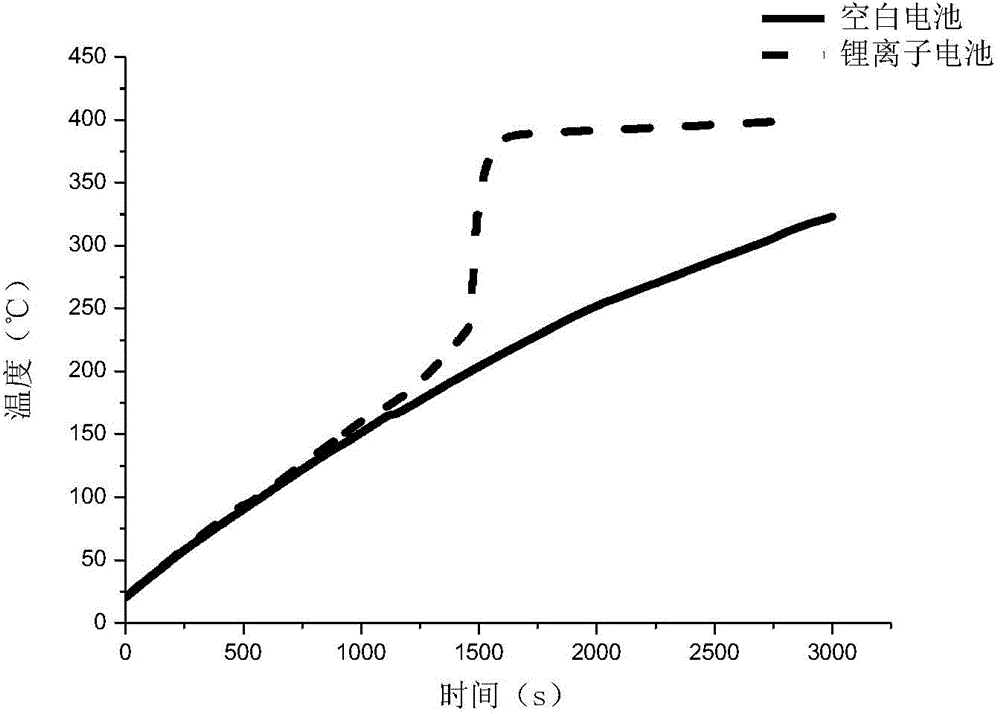Estimation method of lithium ion battery thermal runaway reaction heat
A lithium-ion battery and thermal runaway technology, which is applied to thermometers, measuring electricity, and calorimeters that use directly heat-sensitive electric/magnetic components, can solve the problem that lithium-ion batteries are rarely involved
- Summary
- Abstract
- Description
- Claims
- Application Information
AI Technical Summary
Problems solved by technology
Method used
Image
Examples
Embodiment 1
[0040] The capacity of the lithium-ion battery to be tested in this experiment is 2600mAh, and the battery capacity of 1040mAh is 40% of the capacity.
[0041] The specific heat of the blank battery of this embodiment and the lithium-ion battery to be tested is measured by the mixing method. First, 150ml of hot water is poured into the heat preservation system (insulation cup), and the temperature T of the hot water is measured by the temperature acquisition device. 水1 , and indoor temperature T 室温 , and then put the battery at room temperature into the heat preservation system, let it stand for 10 minutes, and measure the water temperature T after standing 2 , the mass of water m 水 , the mass of the battery m battery Can be measured by electronic balance, through the formula c 水 m 水 (T 水1 -T 2 ) = c p,battery m battery (T 2 -T 室温 ), calculate the specific heat, and get the average value by repeating 3 groups of identical experiments.
[0042] refer to figure 1 The...
Embodiment 2
[0052] Lithium-ion battery power experiment: A lithium-ion battery with a capacity of 2600mAh is uniformly selected. By changing the battery power, batteries with a power of 520mAh, 1040mAh, 1560mAh, and 2080mAh are used as the object of reaction heat estimation. Since the battery mass change is small after the thermal runaway of the lithium-ion battery with low power, the battery mass change is negligible when estimating, and the battery mass is 45.03g; image 3 It is the temperature change curve of lithium-ion batteries with different capacities and blank batteries when the electric heating power is 20W.
[0053] The blank battery is the same as in Example 1, and with reference to the estimation method in Example 1, the reaction heat of thermal runaway of lithium-ion batteries with different battery capacities is estimated. Through calculation, the thermal runaway reaction heats of the batteries with capacities of 20%, 40%, 60% and 80% in this embodiment are 8.5KJ, 19.4KJ, 3...
PUM
 Login to View More
Login to View More Abstract
Description
Claims
Application Information
 Login to View More
Login to View More - R&D
- Intellectual Property
- Life Sciences
- Materials
- Tech Scout
- Unparalleled Data Quality
- Higher Quality Content
- 60% Fewer Hallucinations
Browse by: Latest US Patents, China's latest patents, Technical Efficacy Thesaurus, Application Domain, Technology Topic, Popular Technical Reports.
© 2025 PatSnap. All rights reserved.Legal|Privacy policy|Modern Slavery Act Transparency Statement|Sitemap|About US| Contact US: help@patsnap.com



